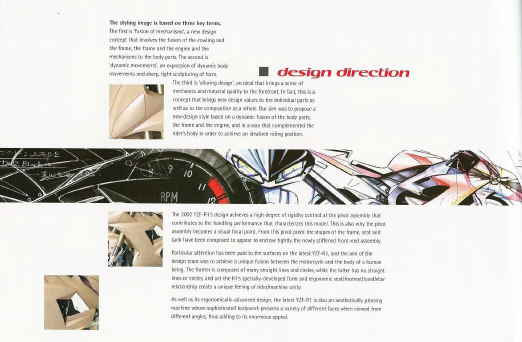|
DESIGN DIRECTION
The styling image is based on three key terms.
The first is ‘fusion of mechanisms’, a new design concept that involves the fusion of the cowling and the frame, the frame and the engine and the mechanisms to the body parts. The second is ‘dynamic movements’, an expression of dynamic body movements and sharp, tight sculpturing of form. The third is ‘alluring design’, an ideal that brings a sense of mechanics and material quality to the forefront. In fact, this is a concept that brings new design values to the individual parts as well as to the composition as a whole. Our aim was to propose a new design style based on dynamic fusion of the body parts, the frame and the engine, and in a way that complemented the rider’s body in order to achieve an idealised riding position.
The 2002 YZF-R1’s design achieves a high degree of rigidity centred at the pivot assembly that contributes to the handling performance that characterizes this model. This is also why the pivot assembly becomes a visual focal point. From this pivot point the shapes of the frame, seat and tank have been composed to appear to enclose tightly the newly stiffened front end assembly.
Particular attention has been paid to the surfaces on the latest YZF-R1, and the aim of the design team was to achieve a unique fusion between the motorcycle and the body of a human being. The former is composed of many straight lines and circles, while the latter has no straight lines or circles, and yet the R1’s specially developed form and ergonomic seat/footrest/handle bar relationship create a unique feeling of rider/machine unity.
As well as it’s ergonomically advanced design, the latest YZF-R1 is also an aesthetically pleasing machine whose sophisticated body work presents a variety of different faces when viewed from different angles, thus adding to it’s enormous appeal.
|
